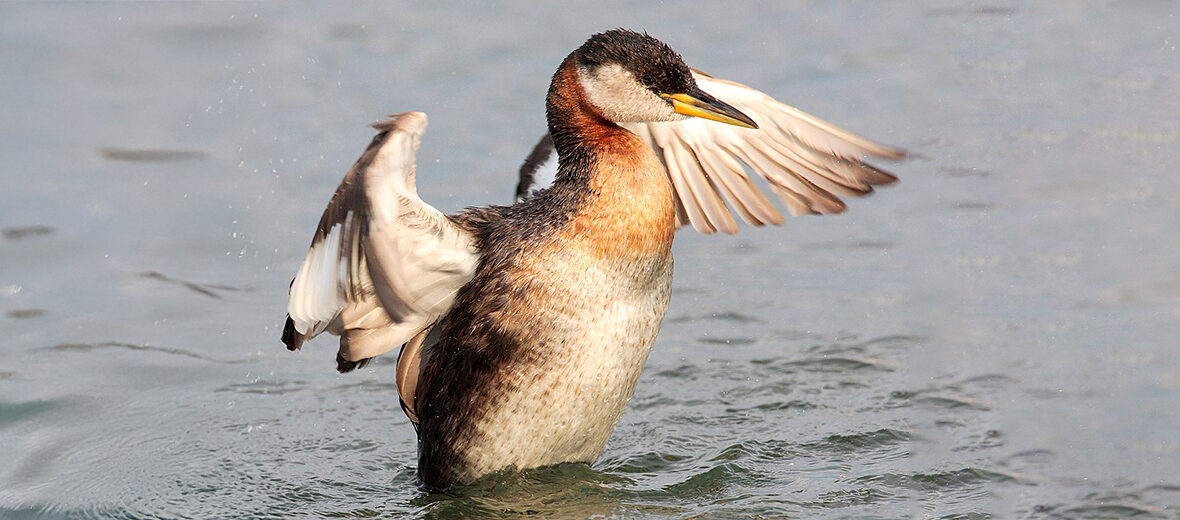
The red-necked grebe is an aquatic, diving migratory bird that can be found throughout the temperate regions of the northern hemisphere. They prefer to dwell in calm waters just past the waves around ocean coasts, like fresh water lakes & marshes, however some individuals will winter on large lakes that have a current. These birds face the threats of habitat destruction at the hands of wood and pulp plantations, freshwater and marine aquaculture, and renewable energy; overfishing; over harvesting; invasive species, and with them disease and predation; agricultural and military pollution; and climate change, and with it habitat shifting and altering weather. However, despite all these challenges they are still abundant enough to be listed as Least Concern by the IUCN. Their numbers are decreasing though.
First the Stats…
Scientific name: Podiceps grisegena
Weight: Up to 56.4 ounces
Length: Up to 22.1 inches
Wingspan: Up to 34.6 inches
Lifespan: Up to 11 years
Now on to the Facts!
1.) These birds prefer to dive, rather than fly away, when danger approaches.
2.) Red-necked grebes were first described by the French polymath Georges-Louis Leclerc, Comte de Buffon in 1781 in his Histoire Naturelle des Oiseaux.
3.) Their feet, like a loon’s, are positioned farther back on their body, near their tail. This makes it challenging to walk on land.
4.) Fossils dating back to the Pleistocene Epoch have been found in Italy.
5.) When flying, their long neck is extended and their large feet trail behind their body, which gives them a stretched-out look.
But wait, there’s more on the red-necked grebe!
6.) They communicate via a loud, howling, wailing “uooooh” display call as well as clucking, hissing, purring, quacking, and rattling calls.
7.) Nests are typically constructed up to 160 feet away from the nearest grebe.
Did you know…?
These birds can dive for up to 2.2+ minutes at a time.
8.) Pairs are monogamous (mate for life).
9.) Their breeding performance consists of head-shaking, a head-lowered “cat” display, parallel rushes in an upward position, and mutual presentations of green weeds, and finishes with a “penguin” dance in which paired members raise their whole body upright, breast to breast.
10.) Parents can leave the nest for long periods of time during the night, possibly to evade nocturnal (active at night) predators. It is uncertain whether this is for self-preservation or to protect the eggs via diverting attention from the nest; the clutch doesn’t seem to suffer from this temporary leave of absence.
But wait, there’s still more on the red-necked grebe!
11.) Females lay up to 5 eggs that hatch in up to 33 days.
12.) Upon hatching, the chicks immediately climb onto their parent’s back, where they stay for up to 17 days.
Did you know…?
Like other grebes, the red-necked grebe typically ingests large amounts of their own feathers, which stay in their stomach. The purpose of this is unknown, although it has been surmised that they assist in protecting the lower digestive tract from bones and other hard, indigestible matter.
13.) Chicks can fly at up to 70 days.
14.) After breeding the adults molt their wing feathers and are temporarily unable to fly. Once these feathers regrow they will migrate.
15.) Raccoons and crows sometimes destroy eggs in an effort to feast on the tasty insides.
But wait, there’s still a little more on the red-necked grebe!
16.) Crayfish, dragonfly larvae, water beetles, and molluscs are all happily feasted upon.
17.) European red-necked grebes feed mostly on fish though.
18.) There are approximately 370,000 wild individuals the world over.
Now a Short Red-Necked Grebe Video!
Be sure to share & comment below! Also, check out the Critter Science YouTube channel. Videos added regularly!
Want to suggest a critter for me to write about? Let me know here.
Some source material acquired from: Wikipedia & IUCN
Photo credit: Mdf




